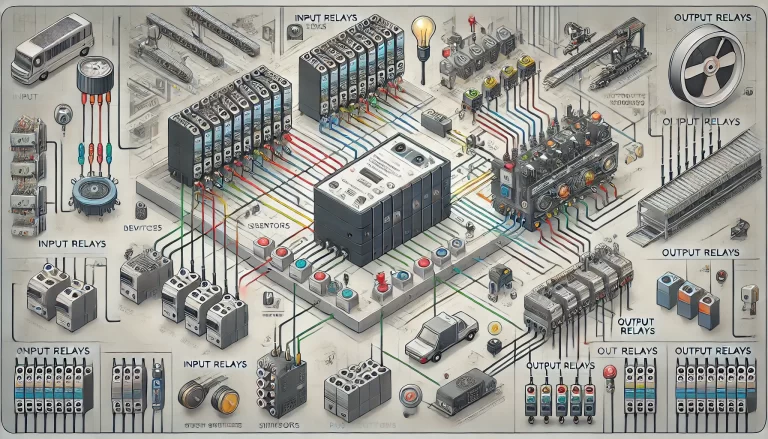In a Programmable Logic Controller (PLC), outputs are used to send control signals to external devices such as motors, lights, relays, solenoids, and valves. These outputs can be broadly categorized into the following types:
🔌 1. Relay Output
Working Principle: Uses an electromechanical relay to switch circuits.
Characteristics:
Compatible with both AC and DC loads.
Provides good electrical isolation.
Slower switching speed due to mechanical movement.
Limited mechanical lifespan (typically hundreds of thousands of operations).
Typical Applications: Powering indicator lights, switching contactors, and controlling small motors.

⚡ 2. Transistor Output
Working Principle: Uses solid-state switching via transistors (either NPN or PNP type).
Types:
NPN (Sink Type): Current flows from load to output.
PNP (Source Type): Current flows from output to load.
Characteristics:
Only suitable for DC loads (typically 24VDC).
Very fast switching, suitable for frequent on/off operations.
Long lifespan with no mechanical wear.
Typical Applications: High-speed counting, DC solenoid control, pulse signal output to stepper drives or encoders.

🌐 3. TRIAC Output
Working Principle: Uses TRIAC (Triode for Alternating Current) to switch AC loads.
Characteristics:
Specifically designed for AC voltage loads (commonly 220V AC).
Medium switching speed.
No moving parts, long operational life.
Typical Applications: Controlling AC-powered heaters, lamps, or contactors.

🔧 4. Analog Output
Types:
Voltage Output: (e.g., 0–10V)
Current Output: (e.g., 4–20mA)
Characteristics:
Provides a continuous output signal rather than discrete ON/OFF.
Used to control devices that require proportional control.
Precision depends on the resolution of the D/A converter in the PLC.
Typical Applications: Speed control of variable frequency drives (VFDs), proportional valve positioning, temperature or pressure control loops.

📊 Summary Table
| Output Type | Load Type | Voltage/Current | Switching Speed | Isolation | Typical Use Case |
|---|---|---|---|---|---|
| Relay Output | AC/DC | Any (depends on model) | Slow | High | General control, switching contactors |
| Transistor Output | DC only (24VDC) | 24VDC | Fast | Medium | High-speed switching, pulse signals |
| TRIAC Output | AC only (e.g., 220V) | 220V AC | Medium | Medium | AC heater or lighting control |
| Analog Output | Analog/proportional | 0–10V or 4–20mA | Continuous | High | VFDs, proportional valves, instrumentation |
